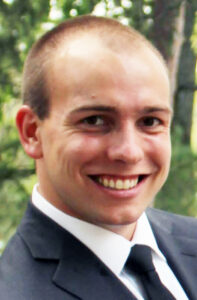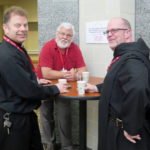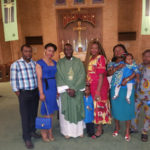By Patrick Schmadeke
There is a statue at Notre Dame University of The Visitation. (Google it.) When I first saw this artwork last year I wasn’t particularly fond of it. It seemed bulky, unrefined and lacking intricate detail. It didn’t depict the elation between Mary and Elizabeth that I associate with the visitation. But they are depicted in a moment of embrace. This is more than we can say for the state of many of our communities today.
The students I teach at Holy Cross College have consistently returned to three themes that they think we need to address in our weakening communities.

First, they think our vocabulary is deprived. This isn’t simply the cheapening of words such as “love” and “awesome.” It’s worse.
While you’re on Google checking out the statue of The Visitation, take a look at Google’s ngram viewer. This tool charts the frequency that a word was used in publications from the 1500s to 2008. In the 20th century, words such as bravery, character, conscience, curiosity, faith, fortitude, gratitude, hope, humility, kindness, prudence, sin, temperance, united, virtue and vocation have gone down in use. Some have dropped off quite dramatically.
On the other hand, words such as business, company, I want, income, job, me, myself, own, personal, personalized, private, resort, self and vacation were all higher at the end of the 20th century then at the beginning.
I don’t mean to paint a one-sided picture. After all, words such as learn, education, tolerance and diversity are on the rise. Despite this, the trend holds true. Words that we use to talk about community life and virtue have been on the decline, while individualistic words are on the rise.
Second, the students think we have become too technology centered. Gallup found that over half of smartphone users check their phones a few times per hour and that over 80 percent of them have their phone near them almost all day. This rings true (pun intended) in my own experience. As I walk across campus, the majority of students are looking down at their phones. But our relationship with technology is not problematic just for young people. On average, retired seniors watch 50 hours of television per week.
Third, my students think society is not attending to people at the margins. Visiting with youths at the Juvenile Justice Center (JJC), whom we see every Tuesday, has been an eye-opening experience for my students. When in group conversation it was pointed out that the retired seniors who watch 50 hours of television per week could spend a few of those hours with the youths at the JJC instead, one of the youths responded, “they don’t care about us.”
This begs some difficult questions. We have to look in the mirror and ask if the world we live in corresponds with the radical conception of Mary: “He has shown might with his arm, dispersed the arrogant of mind and heart. He has thrown down the rulers from their thrones but lifted up the lowly. The hungry he has filled with good things; the rich he has sent away empty” (Luke 1:51-53).
I don’t know how often people think about youths in JJC. I do know that the sign-up list of volunteers could be a lot longer. I do know that the places where we choose to spend our time reflect our values. I do know that we fall sensationally short of Christ’s prayer, “Holy Father, keep them in your name that you have given me, so that they may be one just as we are” (John 17:11).
It strikes me that we are not the world that God intended us to be. The other day I walked by that statue of The Visitation and for the first time it struck me as beautiful. Not because it is intricate. Not because it is radiant in color or evocative of delight. Rather, I saw this depiction of Mary and Elizabeth anew. The simplicity of their tender and full embrace spoke something of God: we are all hewn from the same stone.
(Editor’s note: Patrick Schmadeke is a graduate of St. Ambrose University (‘13) and a student in the Master of Divinity program at the University of Notre Dame. His column offers reflections on his coursework, engaging with the richness of the Catholic Tradition and its relevance to the world today.)











